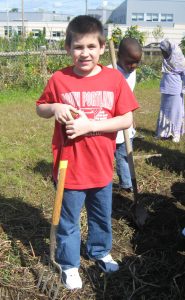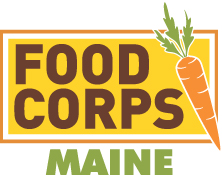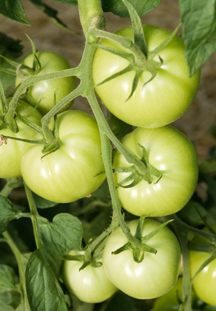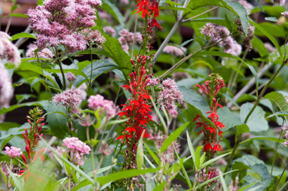Maine Home Garden News — October 2013
- October Is the Month to . . .
- Maine Has Much to Celebrate During National Farm to School Month
- Science in the Garden: Using School Gardens and the Master Gardener Curriculum in High School
- Master Gardeners Plan Skowhegan Rain Garden
By Richard Brzozowski, Agriculturist, UMaine Extension Cumberland County, richard.brzozowski@maine.edu
- Select and plant spring flowering bulbs now. Most spring flowering bulbs prefer light shade to full sun for best growth and flowering next spring. Chose sites that are well drained. If pests have been a problem in digging up bulbs, consider placing a layer of chicken wire flat onto the ground over the planted bulbs. Plant bulbs upright (points up).
- Plant garlic. Just like spring flowering bulbs, plant garlic in October. Mark your row so as not to disturb this area next spring when tilling.
- Take soil samples from your garden or yard for testing. The resulting possible recommendations of nutrients, organic matter, and lime take time to break down. Limestone can take 3 to 6 months to react chemically in the soil to raise the soil pH. Don’t guess — soil test. Over-application of nutrients is not a good practice.
- Clear the garden of those plants that are dead or dying back. Remove the cut stems and debris from the garden. Add a layer compost or manure and integrate it into the soil. Manure will likely add weed seeds when applied, so it is best to compost it first. Integrate the compost into the soil with a flat-tined pitchfork or rototiller. Before too deep into the month and depending on your location in the state, spread a cover crop onto your cultivated garden at the rate of 3-4 pounds per 1000 square feet. As the month progresses, increase the rate of sowing. Winter rye is a traditional winter cover crop. Whole oats can work, too, if conditions permit. The oats will germinate and grow nicely as long as the weather permits. The oats die at the first killing freeze and turns into a brown mat. It does the job of recycling nutrients and holding soil. Next spring, the dead mat of oat growth is easily tilled into the soil. If sowing winter rye, be prepared for some work in tilling it under in the spring. That task of working the winter rye into the soil may call for a rototiller.
- Start or maintain your compost pile. There is typically plenty of organic matter in the fall to form a good size pile, since garden debris, leaves, annual flower debris, and cut stems of herbaceous perennials are all in good supply at this time of year.
- Shade trees provide free organic matter every fall. You could add their fallen leaves to your compost pile. Or, you could run the lawnmower over the leaves to shred them. Shredded leaves can be used as a mulch in the perennial garden. Maple and ash leaves break down quickly compared to oak and beech leaves.
- Review your garden journal for the past growing season and make notes for improvements or plans for next season.
- Drain hoses and store them for the winter. It may also be a good time to check for leaks and to replace worn washers.
- As the lawn mowing season wraps up, make your last mowing a bit shorter than normal. Fall is the best time to fertilize lawns especially for those who fertilize once each year. Lawn fertilizers can be organic or synthetic. Choose the one that best fits your situation.
- After the hard frost, service and store lawnmowers, rototillers and other small-engine garden equipment.
- Collect garden seed. Marigolds, spider flower, calendula, California poppy, flowering tobacco, and nasturtium are all easy to collect. Dry and store over the winter.
- If you are planning to expand your garden next year, start the process now. Cover new sites with a heavy layer of compost, straw, leaves or mulch. This layer should be deep enough to prevent light from hitting any plant growth underneath. Next spring, the soil will be easily tilled. A layer of black plastic can accomplish the same result.
Maine Has Much to Celebrate During National Farm to School Month
By Kate Garland, Horticulturist, UMaine Extension Penobscot County, and Laura Budde, FoodCorps Maine Fellow
 If you’ve ever yanked a carrot out of the ground or prepared a meal with freshly harvested produce, you know how exciting and flavorful gardening and cooking can be. Many Maine youth are being exposed to gardening, nutrition education, and locally sourced food due to the support provided by FoodCorps service members in school districts throughout the state.
If you’ve ever yanked a carrot out of the ground or prepared a meal with freshly harvested produce, you know how exciting and flavorful gardening and cooking can be. Many Maine youth are being exposed to gardening, nutrition education, and locally sourced food due to the support provided by FoodCorps service members in school districts throughout the state.
FoodCorps is a nationwide team of leaders that connects kids to real food and helps them grow up healthy. Maine currently has 10 FoodCorps service members dedicating their next year to teaching kids about food and nutrition, building and tending school gardens, and sourcing local food for school cafeterias.
The University of Maine Cooperative Extension is beginning its third year as the Host Site for FoodCorps in Maine. Here are snapshots of just a few of the many great things last year’s FoodCorps service members supported:
- Garrett Schenck Elementary School in Somerset County hosted a harvest dinner created mostly from food grown by third-graders with the support of former Service Member Laurie Magee.
- Breaducation is a new term at Medomak Valley High School in Waldo County, thanks to Service Member Genna Cherichello, who worked with educator Neil Lash and MVHS students to install a new outdoor oven near their bountiful gardens. Harvest pizza anyone?
- Zoe Hastings served closely with Food Service Director Stephanie Sally at RSU #34 in Penobscot County and area farmers to help bring more locally produced food into the cafeteria. Sally has been a wonderful partner and will surely continue to work hard to support local farmers while feeding youth healthful meals during the school day.
- The two acres dedicated to school gardens and greenhouses at Roberts Farm in Norway are bustling with activity under the leadership of Service Member Dan Rennie. With the help of many students and volunteers over the past two years of service, Dan has raised chickens, developed a hydroponics system, made maple syrup, and has provided over 2,000 pounds of produce to local people facing food insecurity through Maine Harvest for Hunger. He is now working full time as the Roberts Farm Site Coordinator.
- Walker Elementary students enjoyed hands-on learning in the raised bed gardens and greenhouse with service member Katie Morabito. Their horticultural skills earned them a blue ribbon at the Common Ground Fair.
- Students prepared Thai bean wraps at Longley Elementary School in Lewiston under the guidance of Service Member Corbin Lichtinger. Fifth and sixth grade classes tasted and had the opportunity to vote whether this healthy alternative should be added to the school’s lunch menu.
- Lily Joslin coordinated a weeklong cooking camp for youth at River View Comminity School in Gardiner. The camp culminated in an iron chef competition where the kids put their new knowledge to the test using produce grown in their school garden.
- Laura Mailander regularly taught lessons about healthy food and gardening to over 15 classrooms in Portland public schools. Her students prepared recipes using local cranberries, blueberries, strawberries, winter squash, potatoes, rutabaga, carrots, beets, and more! Laura was recently hired by Cultivating Community as their School and Community Garden Coordinator.
- Molly Sauvain supported parents and teachers in creating a new school garden and prolific garden program at Buxton Community Elementary School from the ground up. Their initial Garden Build event included over 20 community members who now sustain the garden as an active garden committee.
- FoodCorps Maine Fellow, Laura Budde, is spreading the word about the art, history, and science of seed saving by connecting seeds and educational resources from the Medomak Valley High School Heirloom Seed Project to schools throughout the state.
Service Site community partners making FoodCorps Maine a tremendous success include Rippling Waters Organic Farm, RSU #3, Oxford Hills Public Schools, Cultivating Community, Healthy Communities of the Capital Area, St. Mary’s Nutrition Center, Washington County: One Community, and University of Maine Cooperative Extension county offices in Penobscot, Piscataquis, Somerset, and Knox-Lincoln Counties.
A new crop of FoodCorps members started their 11 month service term on September 1st. They will continue to support and expand FoodCorps programming at our 10 service sites throughout the state. There’s much excitement about the potential of this group. Follow them on Facebook!
 Additional resources
Additional resources
- More info on FoodCorps
- Maine Agriculture in the Classroom: lesson plans, grants, programs, resources)
- Maine School Garden Network: register your school garden in their state-wide directory!
- University of Maine Cooperative Extension and FoodCorps
Science in the Garden: Using School Gardens and the Master Gardener Curriculum in High School
By Richard Kersbergen, Extension Educator, UMaine Extension Waldo County, richard.kersbergen@maine.edu
 This past year, Islesboro Central School, under the guidance of teacher Ryan Martin, developed a class that integrated the Maine Master Gardener materials into an exciting high school class entitled “Horticultural Science 1.”
This past year, Islesboro Central School, under the guidance of teacher Ryan Martin, developed a class that integrated the Maine Master Gardener materials into an exciting high school class entitled “Horticultural Science 1.”
This novel approach included using the school gardens and high tunnel as part of the laboratory for the class. Using “ Canvas,” Ryan developed modules that students could work through at their own pace and used class time for working in the garden. This model worked well, as students start the class in September with harvesting food from the garden … often the opposite of what most garden classes would do, but since students do most of their academic work on their own, it went well.
Modules included: plant structure, physiology, and growth; taxonomy and nomenclature; soils; plant propagation; entomology; Integrated Pest Management; and plant pathology. Additional sections on hydroponics, tree fruits, vegetables, herbs, and small fruits were also included. Ryan used the National Council for Agriculture Education (NCAE) as a guide for Standards and Competencies.
At the end of the year, University of Maine Cooperative Extension was asked to be an outside evaluator of student competencies. Using questions and concepts from the Master Gardener Program, Rick Kersbergen and Vina Lindley from the UMaine Extension Waldo County office, along with Jenn Brown from the Waldo County Executive Committee, went to Islesboro to administer both a written and oral (hands-on) exam to the students. After the exam, students (and examiners) enjoyed a soils layer chocolate cake!
This fall, building on the success of Ryan’s program, the Waldo County Executive Committee invited high school teachers from throughout the state to come for a day to visit Islesboro and learn what makes the program so appealing. In early September, 18 educators from throughout the state took a beautiful ferry ride out to Islesboro to visit Ryan and his students. We toured the gardens and met with the students, Ryan, and the food service director at Islesboro Central School. A rich discussion followed with some great information sharing of successes and failures in managing school gardens and techniques to meet high school science and math standards.
For more information about Ryan’s program and school garden programs for high school curriculum, contact Vina Lindley in the Waldo County Extension Office at 1.800.287.1426 or vina.lindley@maine.edu.
Master Gardeners Plan Skowhegan Rain Garden
By Brenda Seekins, Somerset County Master Gardener Volunteer from Hartland

The “rain garden” planned recently by the Somerset Master Gardener Volunteers in Skowhegan is on hold.
The project is officially the Hybrid Bioretention Cell Vegetated Underdrain Soil Filter planned in conjunction with the Whitten Brook restoration, in the works for three years now. Master Gardeners were asked to participate this summer as plans for construction drew nearer. The MGVs were tapped to do the planning, choosing local, native plants and participate in the planting. Lack of the appropriate materials to construct the base essentially put the planting on hold, possibly until spring, since the site won’t be ready in time to plant or transplant many of the selected species.
The project began with a special session on the purpose and planning of rain gardens. The University of Maine has an excellent bulletin (#2702) on Adding a Rain Garden to Your Landscape that served as a primer on the concept of rain gardens. Rain gardens are often promoted in sensitive shoreland areas to protect water quality in lakes, streams, and rivers by reducing the amount of polluted runoff reaching the water.
That is the case with Whitten Brook, a natural and historic stream that was once a prime trout fishery in the heart of Skowhegan, contributing to the Kennebec River Watershed. It originates in an undeveloped forested area including a 5.5 acre conservation area, northwest of Coburn Avenue, and covering a watershed area for 304 acres of which 29 percent contains urban and residential development areas. With past conservation efforts, a watershed management plan by the town, the involvement of the Somerset Woods Trusts (regional land trust), Whitten Brook was designated as a Non-Point Source Impaired Water with High Restoration Potential, qualifying for grant funds to complete the work. The primary objective is to reduce the impervious cover (i.e., pavement) within the total watershed, land that promotes runoff and does not allow for natural filtration of the drainage. A rain garden is a small, but important, component of the plan to be located near a former corn processing facility on Russell Road to correct a poorly-designed catch basin and reduce the NPS pollution from the town’s conservation area. In addition, the site will serve as a demonstration project of how a rain garden can contribute to the reduction of polluted runoff and resulting effects on the river and local fishery. The garden will be designed to encourage runoff into the groundwater and not into Whitten Brook.
Approximately seven to eight Master Gardeners met at the UMaine Extension Somerset County office this summer to begin the planning process, an effort that provided its own “teachable moments.” Discussing how to plan a one-acre rain garden, one member of the group, Gail Watson, an Extension employee, shared her experience with garden planning for an “ever—blooming” garden based on The Ever-Blooming Flower Garden: A Blueprint for Continuous Color by Lee Schneller.
 It may look like a quilt or a colorful calendar, but it’s a plan for a rain garden … a big one. Armed with a large sheet of graph paper, the MGVs laid out their plan with colored sticky notes. Color-coding indicates the time of bloom for the designated plants. A code of dots on each paper indicates the height of the designated plant, nearly 30 different native plants. The plants selected were chosen based on their availability as donations from the MGVs personal gardens and through the UMaine Extension Somerset County office. As part of a demonstration project, there was a strong emphasis on choosing only native or locally-viable plants. A list of plants, their proper scientific names, as well as explanatory data on each plant and its characteristics will eventually be available as part of the demonstration project. The completed project is intended to blend into the conservation experience for visitors to the site.
It may look like a quilt or a colorful calendar, but it’s a plan for a rain garden … a big one. Armed with a large sheet of graph paper, the MGVs laid out their plan with colored sticky notes. Color-coding indicates the time of bloom for the designated plants. A code of dots on each paper indicates the height of the designated plant, nearly 30 different native plants. The plants selected were chosen based on their availability as donations from the MGVs personal gardens and through the UMaine Extension Somerset County office. As part of a demonstration project, there was a strong emphasis on choosing only native or locally-viable plants. A list of plants, their proper scientific names, as well as explanatory data on each plant and its characteristics will eventually be available as part of the demonstration project. The completed project is intended to blend into the conservation experience for visitors to the site.
University of Maine Cooperative Extension’s Maine Home Garden News is designed to equip home gardeners with practical, timely information.
Contact Lois Elwell at lois.elwell@maine.edu or 1.800.287.1471 (in Maine).
Let us know if you would like to be notified when new issues are posted. To receive e-mail notifications fill out our online form.
Visit our Archives to see past issues.
Maine Home Garden News was created in response to a continued increase in requests for information on gardening and includes timely and seasonal tips, as well as research-based articles on all aspects of gardening. Articles are written by UMaine Extension specialists, educators, and horticulture professionals, as well as Master Gardener Volunteers from around Maine, with Professor Richard Brzozowski serving as editor.
Information in this publication is provided purely for educational purposes. No responsibility is assumed for any problems associated with the use of products or services mentioned. No endorsement of products or companies is intended, nor is criticism of unnamed products or companies implied.
© 2013
Published and distributed in furtherance of Cooperative Extension work, Acts of Congress of May 8 and June 30, 1914, by the University of Maine and the U.S. Department of Agriculture cooperating. Cooperative Extension and other agencies of the USDA provide equal opportunities in programs and employment.
Call 800.287.0274 or TDD 800.287.8957 (in Maine), or 207.581.3188, for information on publications and program offerings from University of Maine Cooperative Extension, or visit extension.umaine.edu.
